|
NAVIGATION
TOP of Page
MAIN Page
HOME Page
GERM STEAM MAIN
BR01 4-6-2)
BR01.10 (4-6-2)
BR03 (4-6-2)
BR03.10 (4-6-2)
BR18 (4-6-2)
BR19.1 (2-8-2)
BR23 (2-6-2)
BR38 (4-6-0)
BR41 (2-8-2)
BR44 (2-10-0)
BR50 (2-10-0)
BR85 (2-10-2T)
|
DB class 01 Steam Tender Locomotive
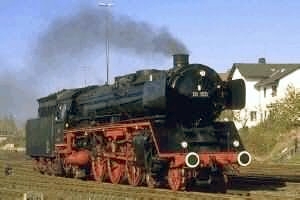
DR 01 150
|
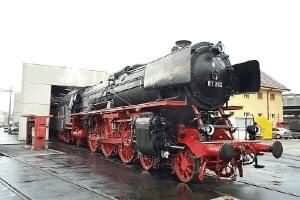
DR 01 202
|
Build Numbers :
:
Builder :
Build Date :
Tender :
Maximum Speed :
Length over Buffers :
Power Continuous :
Wheel Arrangement :
Driving Wheels :
Leading Wheels :
Trailing Wheels :
|
DR 01.2 001-232
DB 001 001-232
Borsig, AEG
1925
T32, T34
130km/h
23.94m
2240HP
2'C1' h2
2000mm
800/1000mm
1250 mm
|
Cylinders :
Cylinder Diameter :
Cylinder Stroke :
Boiler Pressure :
Grate Area :
Heating Surface :
Superheat Surface :
Total Weight :
Adhesion Weight :
Axle Weight :
|
2
600mm
600mm
16kp/cm^2
4.41m^2
247.25m^2
85.00m^2
108.9t
59.2t
20.20t
|
The two cylinder Class 01 was the first standard express locomotive for the
Deutsche Reichsbahn. Until 1937 the only suppliers were Borsig and AEG; other
companies joined later. The DR had a total of 231 machines.Locomotives from
number 01-102 onwards received front bogie wheels with a diameter of 1000mm.
Stronger brakes permitted an increase of in smoke chamber niches behind the large
smoke deflectors, were shifted into the middle of vehicle for greater visibility.
Some of the locomotives were fitted with the substantially smaller and less
effective Witte smoke deflectors and were not adapted.
In 1950-1951 the D.B. equipped 5 machines (01-042, 046, 112, 154, 192) with
turbo-feed pumps and Henschel mixing preheats of the Heinl design. In addition
combustion chambers were built into the boilers. These locomotives can easily
be differentiated by the unusual form of the smoke box. In 1963 all these
locomotives were superseded with exception of 01-192.
Starting from 1957, the D.B. equipped 50 locomotives with new welded high
pressure boilers as used on the 01_10 class. Outwardly the modified locos
differ from the original by the large diameter low chimney and by the absence
of steam domes. A new mixing preheat was built into the smoke box and the old
sliding bearings were replaced with anti-friction bearings. Changes at the
cylinder block, front frame and piping give the locomotives a more aggressive
appearance.
TOP
MAIN
HOME
DB class 01.10 Steam Tender Locomotive
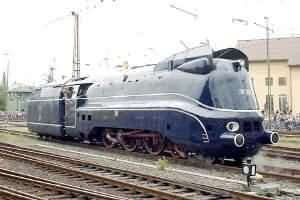
DR 01.10 1102
|
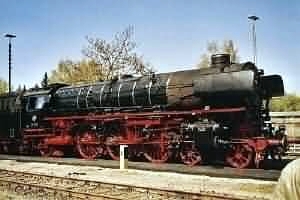
DR 01.10 1066
|
Build Numbers :
:
Builder :
Build Date :
Tender :
Maximum Speed :
Length over Buffers :
Power Continuous :
Wheel Arrangement :
Driving Wheels :
Leading Wheels :
Trailing Wheels :
|
DR 01.10 1001
1052-1105
DB 011 012 1001
1052-1105
Schwatzkopff
1937
T38
140km/h
24.13m
2120HP
2'C1' h3
2000mm
1000mm
1250mm
|
Cylinders :
Cylinder Diameter :
Cylinder Stroke :
Boiler Pressure :
Grate Area :
Heating Surface :
Superheat Surface :
Total Weight :
Adhesion Weight :
Axle Weight :
|
2
500mm
660mm
16kp/cm^2
4.32m^2
247.15m^2
86.00m^2
114.3t
60.2t
20.9t
|
The Class 01.10 had the aerodynamic bodywork removed by the DB after WW II to become the Coal
fired class 011 and the Oil fired class 012. Initially a series of 250 three-cylinders machines
locomotives were planned. The locomotives were intended for fast service with modern passenger
trains. By the outbreak of the WW II only 55 locomotives were supplied by Schwartzkopff. Some of
the locomotives had full streamlining, which was soon deleted due to problems with combustion
air supply and maintenance accessibility. The cancellation of orders left a large number of
intended operating No's remained vacant.
All 55 locomotives of the class 01.10 survived the WW II. After 1945 the rotten linings were
removed and any small damage was repaired. At this point the specialised steel used in the
boilers showed signs of bad fatigue. New spare welded boilers and combustion chambers were
ordered, with production by Henschel and installation in Braunschweig works. In 1959 locomotive
01.1100 was first fitted with oil auxiliary firing and later, together with 33 more machines,
with oil main firing. Together with the locomotives of class 10, the oil fired 01.10 locomotives
provided for heavy express trains.
TOP
MAIN
HOME
DB class 03 Steam Tender Locomotive
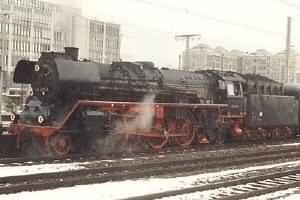
DB 03_2295-8
|
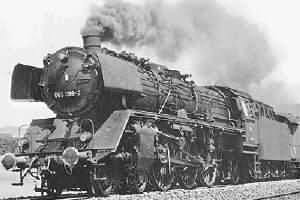
DB 03 088-2
|
Build Numbers :
:
Builder :
Build Date :
Tender :
Maximum Speed :
Length over Buffers :
Power Continuous :
Wheel Arrangement :
Driving Wheels :
Leading Wheels :
Trailing Wheels :
|
DR 03.2 001-298
DB 03.2 011 012
1001 1052-1105
Borsig, AEG
1930
T30, T32, T34
130km/h
23.905m
1980HP
2'C1' h2
2000mm
800/1000mm
1250mm
|
Cylinders :
Cylinder Diameter :
Cylinder Stroke :
Boiler Pressure :
Grate Area :
Heating Surface :
Superheat Surface :
Total Weight :
Adhesion Weight :
Axle Weight :
|
2
570mm
660mm
16kp/cm^2
3.97m^2
201.96m^2
70.00m^2
100.3t
54.3t
18.2t
|
From 1930 the class 03 locomotives were built as a lightweight version of the class 01 for routes limited
to 20 tonnes axle load. Boilers and cylinders were smaller and the riveted frameworks were simpler.
03 123 onwards had the pumps shifted to the middle of loco and from 03 163 onwards the front bogie wheels
were changed to 1000mm. Locomotive 03 175 received Lentz valve gear with 03 154 & 193 receiving a part
and/or a full lining. Until 1937 the D.R. fielded 298 locomotives of this class. From 1962 the D.B. in
Central Germany had all remaining machines equipped with mixing preheats.
TOP
MAIN
HOME
DB class 03.10 Steam Tender Locomotive
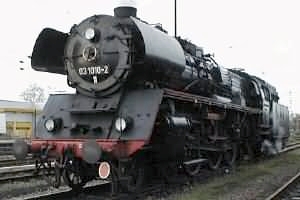
DB 03.10 1010-2
|
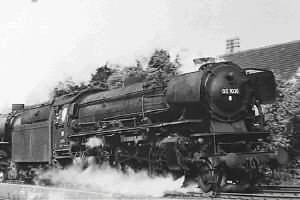
DR 03.10 1075
|
Build Numbers :
:
Builder :
Build Date :
Tender :
Maximum Speed :
Length over Buffers :
Power Continuous :
Wheel Arrangement :
Driving Wheels :
Leading Wheels :
Trailing Wheels :
|
DR 03.10 001-232
DB 03 1001-22
1043-60, 1073-92
Borsig,Krupp,Krauss
1937
T38
140km/h
24.13m
2120HP
2'C1' h3
2000mm
1000mm
1250mm
|
Cylinders :
Cylinder Diameter :
Cylinder Stroke :
Boiler Pressure :
Grate Area :
Heating Surface :
Superheat Surface :
Total Weight :
Adhesion Weight :
Axle Weight :
|
2
570mm
600mm
16kp/cm^2
4.32m^2
247.15m^2
86.00m^2
114.3t
60.2t
20.9t
|
The class 03.10 locomotive was planned as an upgrade of the class 03 with full streamlining.
Until 1941 only 60 machines were delivered due to the war. Originally built by Borsig of Berlin
Krupp and Krauss-Maffei had soon became involved. Only 45 of the class survived WW II and as
with the class 01.10 the full streamlining and engine apron were removed.
The D.B. acquired 26 working locos and the remainder underwent reconstruction from 1957.
Compression testing of the boilers showed 03 1046 to have burst briefly before.
The fairings were also found to be in a very bad condition and were all removed before 1950.
As with class 01.10 boilers fatigue was noticed. Krupp received an order for new welded boilers
with combustion chambers which were built in Braunschweig Works. The locomotives now resembled
the class 01.10. Behind the large diameter chimney only the throttle and steam dome were visible.
Sand was carried in two containers alongside the boiler. After the modifications all the machines
were stationed in Hagen/Westfallen and in 1966 were superseded there by dieselisation. Operating
No's were: 03 1001 1004 1008 1009 1011-1014 1016-17 1021-22 1043 1045 1049-51 1054-56 1060 1073
1076 1081 1082 1084.
TOP
MAIN
HOME
DB class 18 Steam Tender Locomotive
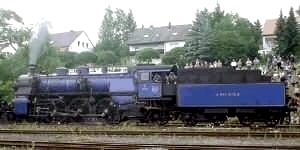
DR 18 004
|
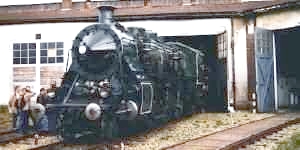
DR 18 478
|
Build Numbers :
:
Builder :
Build Date :
Tender :
Maximum Speed :
Length over Buffers :
Power Continuous :
Wheel Arrangement :
Driving Wheels :
Leading Wheels :
Trailing Wheels :
|
KBStB S3/6 3601-78
DR 18 401-434
DR 18 461-478
Maffei
1908
T26.24
120 km/h
21.396 m
1770 HP
2'C1' h4v
1870 mm
950 mm
1206 mm
|
Cylinders :
Cylinder Diameter :
Cylinder Stroke :
Boiler Pressure :
Grate Area :
Heating Surface :
Superheat Surface :
Total Weight :
Adhesion Weight :
Axle Weight :
|
4 Compound
425/650mm
610/670mm
15kp/cm^2
4.53m^2
197.41m^2
74.16m^2
88.3t
49.6t
16.8t
|
The Royal Bavarian Railways (Koniglich Bayerish Staats Bahn) K.B.St.B. class S3/6 is regarded
as one of the worlds most beautiful locomotives and is very popular. Maffei supplied 71 locos from
1908 to 1918 with a wind cutting front to the cabin. The S3/6 locomotives were very economical
machines with extraordinary running qualities. WWI repatriation locomotives went to France as ETAT
class 231 and to Belgium the remainder staying with the German National Railroad.
A special use for the S3/6 was the luxurious Rhinegold express. In the summer of 1960 the last
locomotive with a wind cutting front to the cabin 18 478 was superseded from the German Federal
Armed Forces at Ulm. It was despatched to Ulm Museum in 1960 and then transferred to Lindau in 1962.
There it was given an expensive restoration by Swiss engineer Lory and placed in the Luzern Transport
Museum in 1966. Loco 18 451 is in the German Museum in Munich.
Another series of 18 machines with flat cabin fronts were delivered from 1912 to 1913. They differed
from the others in several details. Driving wheels were increased to 2000mm diameter. The stroke of
the high pressure cylinders was increased to 670mm and thus better adapted to the low pressure cylinder.
The boiler center was raised to 2930mm to accomodate the larger wheels and the wheel base was increased.
Tenders were of the type 2'2 T32.5 with a front bogie and two fixed rear axles - thus the larger wheel
base of the locomotive was balanced by the shorter wheel base of the tender. All 18 locomotives were
taken over by the National Railroad.
The second procurement period of S3/6 locos extended over the period of 1923-30. The first delivery from
Maffei covered 30 locomotives which were in service from 1923-24. From 1927-28 Maffei supplied another 20
locos and in 1930 supplied only 2 locos. Tradition steeped Maffei had been hit by the world recession so
the last series of S3/6 were built under license by Henschel in 1930-31. Two locomotives of the 18.5 class
are preserved. Locomotive 18 505 was with BZA Minden in 1963 and 18 528 which was acquired in 1963 by
Krauss Maffei and set up in Munich-Allach.
TOP
MAIN
HOME
DB class 19.1 Steam Tender Locomotive
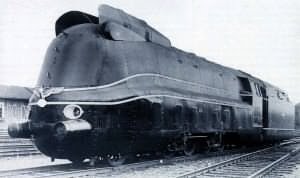
DR 19 1001
|
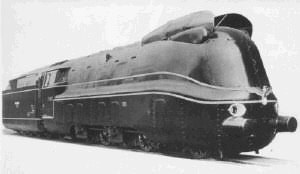
DB 19 1001
|
Build Numbers :
Builder :
Build Date :
Tender :
Maximum Speed :
Length over Buffers :
Power Continuous :
Wheel Arrangement :
Driving Wheels :
Leading Wheels :
Trailing Wheels :
|
DR 19 1001
Henschel
1942
T38
175km/h
23.775m
1700HP
1'Do1'
1250mm
1100mm
1250mm
|
Cylinders :
Cylinder Diameter :
Cylinder Stroke :
Boiler Pressure :
Grate Area :
Heating Surface :
Superheat Surface :
Total Weight :
Adhesion Weight :
Axle Weight :
|
8 (4 of V-2)
300mm
300mm
20kp/cm^2
4.55m^2
239.67m^2
100.00m^2
109.3t
74.6t
18.7t
|
The remarkable class 19.1001 was a V8 locomotive having four V2 engines, one for each driving axle.
The wheel arrangement was 2-8-2 (Mikado). 19.1001 was originated by Fredrick Witte, head of testing
and development for the DR (German State Railways). The concept was first discussed in the DR in
1933 and plans drawn up in 1935. The detail design was done by Richard Roosen of Henschel & Son.
It was delivered to the DR in July 1941.
With the class 19 new concepts in building and design were investigated and tested on a steam engine.
Following already existing electric locomotives with individual axle drive Henschel designed a steam
engine with which each individual drive axle was driven by a steam motor. Previous steam engines had
been built as two-cylinder machines in V arrangement. After an initial lack of success in test runs
when the locomotive was used from 1943 in regular express train service it then exceeded design
expectations.
In October 1944 19.1001 was seriously damaged during an air raid on Hamburg. It was moved to RAW
Braunschweig and stayed there until the end of the war. In August 1945 the locomotive was brought back
to Henschel repaired and after one test run between Kassel and Wabern was shipped to the USA in October
1945. It was sent to Fort Monroe in Virginia for testing and inspection and in 1950 was moved to Fort
Eustis in Virginia and scrapped there in 1952.
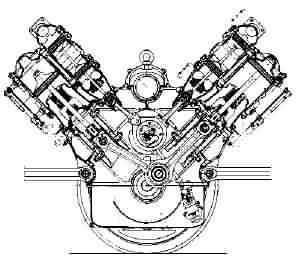
V motor elev
|
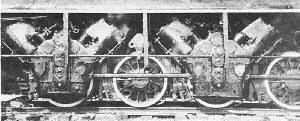
Steam V motors
|
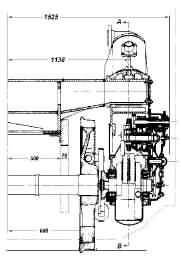
V motor end elev
|
TOP
MAIN
HOME
DB class 23 Steam Tender Locomotive
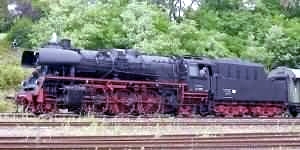
DR 23 004
|
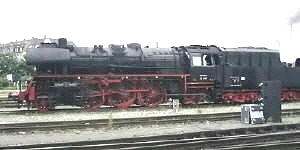
DB 23 1097
|
Build Numbers :
Builder :
Build Date :
Tender :
Maximum Speed :
Length over Buffers :
Power Continuous :
Wheel Arrangement :
Driving Wheels :
Leading Wheels :
Trailing Wheels :
|
DB 23 001-105,
1001-1113
Henschel
1950
T31
110km/h
21.325m
1,785HP
1'C1' h2
1750mm
1,000mm
1,250mm
|
Cylinders :
Cylinder Diameter :
Cylinder Stroke :
Boiler Pressure :
Grate Area :
Heating Surface :
Superheat Surface :
Total Weight :
Adhesion Weight :
Axle Weight :
|
2
550mm
660mm
16 kp/cm^2
3.11m^2
156.28m^2
82.8t
56.0t
18.67t
|
By 1940 the German National Railroad had procured no further passenger train locomotives except the class 24.
At this time a replacement for the P8 was needed. Schichau prepared a draft and supplied two prototypes in 1944.
Development was delayed due to WW II. The boiler and tender of the class 50 were used due their proven qualities.
Efficiency and running properties were to expectation. After the war both machines remained with VES-M Halle.
They were equipped there with new boilers in 1961.
It took until 1949 to begin mass construction of the class 23. Henschel supplied the first machines in 1950 with
dimensions that matched the prototypes. Frameworks, boilers and tenders were now modern welded structures. Up to
loco 23 052 were fitted with surface preheaters and sliding bearings. All following locos received antifriction
bearings and mixing preheaters, which had been tested before in the locomotives 23 024 & 025. Some received
two-stage Heinl preheaters. In December 1959 locomotive 23 105 was delivered as the last steam engine of the
German Federal Railroad.
TOP
MAIN
HOME
DR class 38.1 / DB class 038 Steam Tender Locomotive
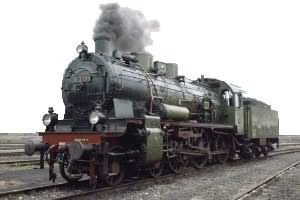
DR 38 3199
|
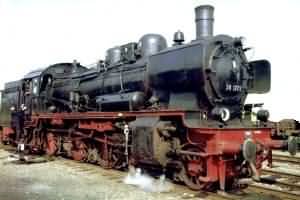
DB 38 1772
|
Build Numbers :
:
Builder :
Build Date :
Tender :
Maximum Speed :
Length over Buffers :
Power Continuous :
Wheel Arrangement :
Driving Wheels :
Leading Wheels :
|
DR 38.1 1001-4052
DB 038 1001-4052
K.P.E.V.
1906
T21.5, T31.5, T30
100km/h
18.592m
1180HP
2'C h2
1750mm
1000mm
|
Cylinders :
Cylinder Diameter :
Cylinder Stroke :
Boiler Pressure :
Grate Area :
Heating Surface :
Superheat Surface :
Total Weight :
Adhesion Weight :
Axle Weight :
|
2
575mm
630mm
12kp/cm^2
2.58m^2
143.28m^2
58.90m^2
78.2t
51.6t
17.7t
|
Director Robert Garbe originally designed the Class P8 for the Königlich Preussiche Eisenbahn Verwaltung
(Royal Prussian Railway Administration). The boiler was hugely successful, although the maximum speed was
reduced from 110 to 100 km/h due to wheel balancing. The original wind cutting front to the cabin was also
dropped in series production. The good reputation of the P8 led to several orders from foreign railway
administrations.
The Prussian state railway procured 3370 locos of the approximately 3800 total built until 1928. More than
3000 locos were incorporated into the National Railroad as the 38.10-40 class. The German Federal Railroads
changed the large Wagner smoke deflectors for the smaller Witte design. A large number of locos received
Wannen tub tenders of the type 2'2' T30. In 1968 approximately 300 machines were still in stock, mainly with
the East German Deutsche Reichsbahn.
TOP
MAIN
HOME
DR class 41.1 / DB class 041.1 Steam Tender Locomotive
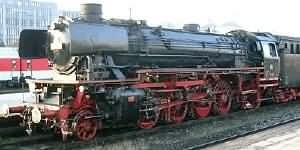
DR 41 018
|
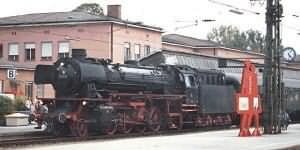
DR 41 018
|
Build Numbers :
:
Builder :
Build Date :
Tender :
Maximum Speed :
Length over Buffers :
Power Continuous :
Wheel Arrangement :
Driving Wheels :
Leading Wheels :
Trailing Wheels :
|
DR 41.1 001-366
DB 041.1 001-366
Schwarzkopff
1936
T30, T32, T34
90km/h
23.905m
1900HP
1'D1' h2
1600mm
1000mm
1250mm
|
Cylinders :
Cylinder Diameter :
Cylinder Stroke :
Boiler Pressure :
Grate Area :
Heating Surface :
Superheat Surface :
Total Weight :
Adhesion Weight :
Axle Weight :
|
3
520mm
720mm
16kp/cm^2
3.89m^2
203.15m^2
72.22m^2
101.9t
78.0t
19.7t
|
In 1936 Schwartzkopff supplied the class 41 as the first fast goods locomotive. It soon soon became
obvious the loco was good for universal use for moderately severe work. A redeveloped chassis was
paired with the excellent boiler from the class 03. From 1936-41 a total of 366 locos were delivered
from nearly all German locomotive factories. After 1945 approx. 220 machines remained in West Germany
where they were used in all regions. The Boil Pressure was reduced from 20 to 16 kp/cm^2 to avoid
boiler damage. Accelerated retirement began in 1966 for the locos that had not received new boilers.
At the beginning of the 1950's the 41 class showed fatigue in the boiler steel. From 1957-61 99 new
locos were delivered with welded boilers identical to those on the class 03.10. Changes were made to
the front frame which gave the locos a powerful and pleasing appearance. Oil main firing was fitted
to 40 locos. The DR in Central Germany equipped a large part of the fleet with new boilers of different
design and fitted the new Knorr preheaters. The class were known as "Ochsenloks" - "Oxen Locs" due to
their use on cattle trains in WW2.
TOP
MAIN
HOME
DR class 44.1 / DB class 044.1 Steam Tender Locomotive
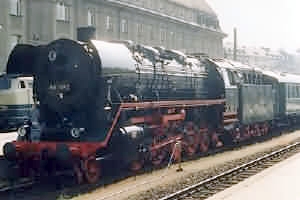
DR 44 1093
|
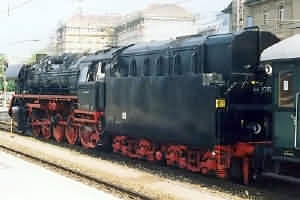
DR 44 1093
|
Build Numbers :
:
Builder :
Build Date :
Tender :
Maximum Speed :
Length over Buffers :
Power Continuous :
Wheel Arrangement :
Driving Wheels :
Leading Wheels :
|
DR 44 001-1516
DR 44 1521-1858
DB 044 001-1516
DB 044 1521-1858
Henschel, Schwarzkopf
1926
T30, T32, T34
80km/h
22.620m
1910/2100HP
1'E h3
1400mm
850mm
|
Cylinders :
Cylinder Diameter :
Cylinder Stroke :
Boiler Pressure :
Grate Area :
Heating Surface :
Superheat Surface :
Total Weight :
Adhesion Weight :
Axle Weight :
|
3
550mm
660mm
16kp/cm^2
4.55m^2
237.67m^2
100.00m^2
110.2t
95.9t
19.3t
|
After a first order of 10 locos two further locomotives followed in 1932. Large scale production commenced
in 1937. Until 1945 approx 2000 machines were supplied for use at home and abroad. A number went to France
and remained there after WW II. In 1950 the railways equipped locos 44 239 241 242 244 & 246 with new
combustion chambers and mechanical stokers. In the same year 44 433 475 629 1174 & 1210 likewise received
new combustion chambers and mixing pre-heaters. From 1955 32 locos were converted to oil main firing. The
DR in Central Germany proceeded in a similar way. Coal Dust firing was fitted to 20 locos. In 1968 numerous
machines were still in use with the original setup. They were affectionately known as 'Jumbos' due to their
size.
Two more locos which should had received the Serial No's M 02 1004 and 1005 were assigned to the 44 class.
The two were built for comparison purposes. Despite considerable design input the locomotives were not
satisfactory. Expensive boiler and fire box damage was obvious after short working lives and so the Boiler
Pressures were reduced to 16 MP. Loco 44 011 was decommissioned in the mid fifties and thus 44 012 came as
a unique piece to the VES-Museum of the the German National Railroad.
TOP
MAIN
HOME
DR class 45.1 / DB class 045.1 Steam Tender Locomotive
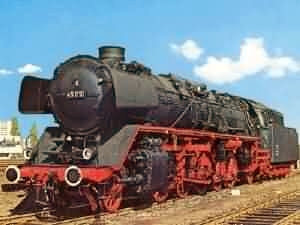
DR 45 010
|
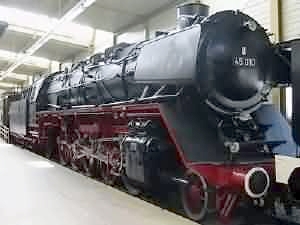
DR 45 010
|
Build Numbers :
Builder :
Build Date :
Tender :
Maximum Speed :
Length over Buffers :
Power Continuous :
Wheel Arrangement :
Driving Wheels :
Leading Wheels :
Trailing Wheels :
|
DR 45 001-028
DB 045 001-028
Henschel
1936
T38, T39 Stk
90km/h
25.645m
2800/3020HP
1'E1' h3
1600mm
1000mm
1250mm
|
Cylinders :
Cylinder Diameter :
Cylinder Stroke :
Boiler Pressure :
Grate Area :
Heating Surface :
Superheat Surface :
Total Weight :
Adhesion Weight :
Axle Weight :
|
2
520mm
720mm
16kp/cm^2
4.47m^2
269.02m^2
120.00m^2
97.2t
67.5t
19.7t
|
* refers to Loco 45 003 Tender T29 which had a mechanical stoker.
TOP
MAIN
HOME
DR class 50.1-31 / DB class 050-053 Steam Tender Locomotive "Kreigslok"
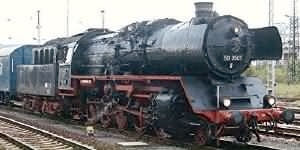
DR 50 3501
|
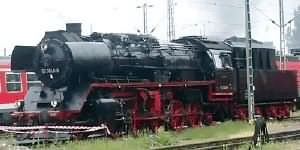
DB 50 3648-8
|
Build Numbers :
Builder :
Build Date :
Tender :
Maximum Speed :
Length over Buffers :
Power Continuous :
Wheel Arrangement :
Driving Wheels :
Leading Wheels :
|
DR 50.1-31 001-3171
DB 050-053 001-3171
Reichsbahn
1939
T26, T30
80km/h
22.940m
1625HP
1'E h2
1400mm
850mm
|
Cylinders :
Cylinder Diameter :
Cylinder Stroke :
Boiler Pressure :
Grate Area :
Heating Surface :
Superheat Surface :
Total Weight :
Adhesion Weight :
Axle Weight :
|
2
660mm
660mm
16kp/cm^2
3.89m^2
177.83m^2
68.94m^2
86.9t
75.3t
15.2t
|
Standard War Loco "Kreigslok"
Tenders: 730 locos fitted with Kab (Cabin) Tenders others with Wannen (Tub) Tenders.
Boilers: 31 locos fitted with Franco-Crosti boilers 50 3011 & 3012 fitted with Brotan boiler.
WW2 Repatriation : Austria OeBB class 50, France SNCF class 150X, Holland NS class 49, Belgium SNCB class 25, Denmark DSB
TOP
MAIN
HOME
DR class 52.1-9 / DB class 052 Steam Tender Locomotive "Kreigslok"
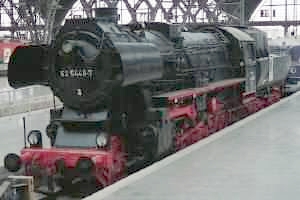
DB 52 5448-7
|
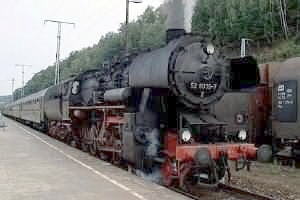
DB 52 8079-7
|
Build Numbers :
Builder :
Build Date :
Tender :
Maximum Speed :
Length over Buffers :
Power Continuous :
Wheel Arrangement :
Driving Wheels :
Leading Wheels :
|
DR 52.1-9 001-7794
DB 052 001-7794
Reichsbahn
1942
T30 Wannen
80km/h
22.975m
1620HP
1'E h2
1400mm
850mm
|
Cylinders :
Cylinder Diameter :
Cylinder Stroke :
Boiler Pressure :
Grate Area :
Heating Surface :
Superheat Surface :
Total Weight :
Adhesion Weight :
Axle Weight :
|
2
600mm
660mm
16kp/cm^2
3.89m^2
177.83m^2
68.94m^2
84.0t
75.7t
15.4t
|
Designed as WW2 Standard "Kreigslok". Simplified construction development of class 50. Last retirement from service 1963.
TOP
MAIN
HOME
DR class 85 / DB class 085 Steam Tank Locomotive
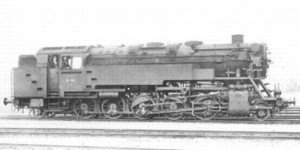
DR 85 004
|
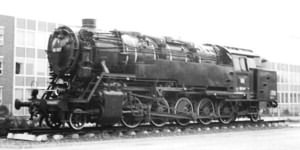
DR 85 007
|
Build Numbers :
Builder :
Build Date :
Maximum Speed :
Length over Buffers :
Power Continuous :
Wheel Arrangement :
Driving Wheels :
Leading Wheels :
Trailing Wheels :
|
DR 85 001-010
DB 085 001-010
Henschel
1932
80km/h
16.30m
1500HP
1'E1'
1400mm
850mm
850mm
|
Cylinders :
Cylinder Diameter :
Cylinder Stroke :
Boiler Pressure :
Grate Area :
Heating Surface :
Superheat Surface :
Total Weight :
Adhesion Weight :
Axle Weight :
|
3
600mm
660mm
14kp/cm^2
3.55m^2
195.95m^2
72.50m^2
133.6t
99.7t
20.1t
|
TOP
MAIN
HOME
|


